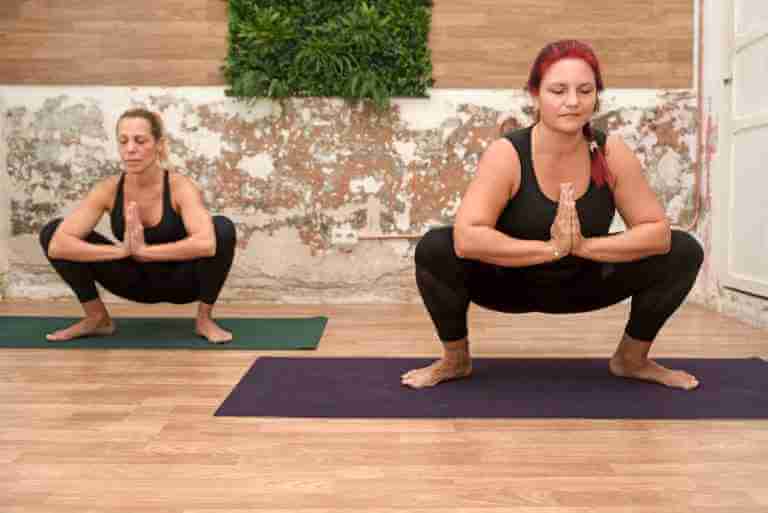Home » Yoga Blog » Yoga Poses » Saddle Pose Yin Yoga Supta Vajrasana – Complete Guide
Saddle Pose Yin Yoga Supta Vajrasana - Complete Guide
Yin Yoga, a style of yoga known for its deep, passive stretches, includes the Saddle Pose (Supta Vajrasana in Sanskrit) as one of its essential asanas. With its unique blend of relaxation and stretch, this pose offers numerous benefits, making it a favoured choice among yoga practitioners.
Benefits of Saddle Pose
Supta Vajrasana The Saddle Pose primary benefit is its profound opening in the sacral-lumbar arch, effectively stretching the hip flexors and quadriceps.
This stretch is particularly beneficial for athletes and those who engage in standing or walking activities. When performed with the neck dropped back, it stimulates the thyroid gland.
Additionally, positioning the feet beside the hips in this pose encourages good internal hip rotation.

Saddle Pose: Step-by-Step Guide
Here’s an expanded guide on how to do Supta Vajrasana, the Saddle Pose in Yin Yoga:
- Starting Position: Begin by sitting in your heels. Pay attention to how your ankles feel. If there’s discomfort, consider placing a blanket or folded towel under them for padding, especially on hard floors.
- Ankle and Knee Adjustment: Check your knees since the Saddle Pose involves deep knee flexion. If discomfort in your thighs and calves is considerable, place blocks or cushions between your feet to sit higher, reducing knee stress.
- Leaning Back: Next, lean back on your hands. This Position creates stress along the top of the thighs and front of the hips. This might be as far as you go in the Pose, and that’s perfectly fine.
- Listening to Your Body: If the Pose becomes too much, you can exit and switch to a Sphinx Pose, resting on your elbows and lifting your chest.
- Using Bolsters: If you’re a bit more advanced (Track two students), consider resting your back on a bolster, supporting your spine better. You can open your arms to the sides or overhead to increase the hip sensation in this Position.
- Full Saddle Pose: More flexible individuals (Track three students) can lower to the floor. Here, you can also bring your arms overhead. It’s normal if your knees lift off the floor slightly, indicating tightness in the quadriceps.
- Focus on Sensation: Remember, it’s not about how the Pose looks but how it feels. The goal is to experience the sensation, not achieve a particular appearance.
- Relax and Close Your Eyes: Once you find the version of the Pose that works for you, close your eyes and settle into the sensation, focusing on your breath and the stretch.
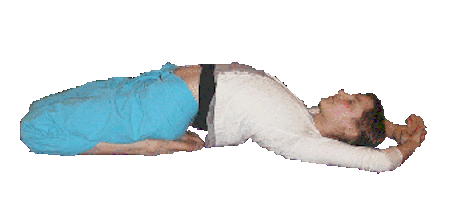
Saddle Pose Video How to
Saddle Pose vs. Hero Pose
While similar in appearance, Saddle Pose (Supta Vajrasana) and Hero Pose (Virasana) differ significantly in intensity and the areas they target. The legs are in the same position, however Hero Pose the practitioner is seated up right while in Saddle Pose the practitioner is laying down.
Hero Pose is generally considered less intense and more accessible, especially for beginners or those with knee sensitivity. The Saddle Pose offers a more intense experience with its deeper backbend and stretch.
Saddle Pose for Beginners

For beginners, it’s essential to approach the Supta Vajrasana Saddle Pose with caution. Starting simply by sitting on the heels and noticing the body’s response is an excellent first step. If there’s any pain in the knees or ankles, it’s advised to either use a blanket for support or skip the pose entirely. Beginners can lean back on their hands to create a gentle arch in the lower back and proceed only as comfortably as possible.
Variations of the Pose
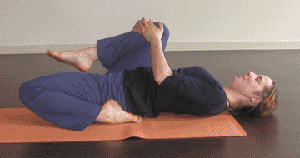
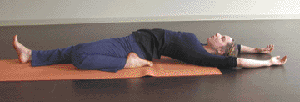
Several variations of the Saddle Pose cater to different levels of flexibility and comfort. One popular variation is the Half Saddle, where one leg is straightened, offering extra stretch and intensity. Other variations include:
- Resting on the elbows.
- Using bolsters for support.
- Placing a block between the feet and under the buttocks for an elevated hip position.
These variations ensure that practitioners at all levels can safely enjoy Supta Vajrasana benefits.
Half Saddle Pose Benefits

The Half-Saddle Pose, in which one Leg is extended, offers specific benefits, such as a more targeted stretch in the quadriceps and hip flexors of the extended Leg.
With blocks or bolsters under the buttocks or back, this varaiation allows for more significant adjustments, making it suitable for those with limited flexibility or knee issues.
You can try this Variation of the Pose in two ways:
- Forward Folding Half Saddle Pose (Ardha Baddha Padma Paschimottanasana in Sanskrit): Folding over the extended Leg (see image above)
- Reclining Half Saddle Pose (Ardha Virasana in Sanskrit): Reclining backward with the upper body moving to the floor. (see Video Below)
Alternative to Saddle Pose
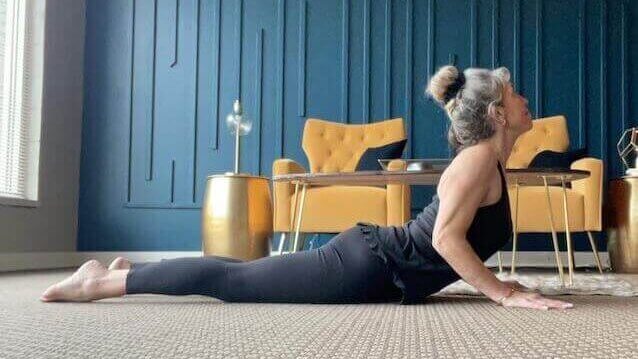
For those who find the Saddle Pose too intense for the lower back, the Sphinx Pose or Cobra pose is an excellent alternative. This pose offers a milder stretch while still being beneficial.
Counter Pose to Saddle
After practicing Supta Vajrasana, engaging in counter poses to balance the body is beneficial. Lying quietly on your back, moving into a Child’s Pose, or engaging in Crocodile or Push-up poses are effective ways to release any tension accumulated during the Saddle Pose.
Exiting the Pose
Exiting Supta Vajrasana the Saddle Pose involves gradually coming up onto the elbows and hands and then lying down on the belly to allow the knees to release gently. This careful exit helps to prevent any strain or discomfort
The Pose Impact On Chakras

We can expand our understanding of its holistic impact by incorporating a section on the chakras affected by the Saddle Pose in Yin Yoga. This pose primarily influences the Svadhisthana (Sacral) and Manipura (Solar Plexus) chakras.
The Svadhisthana Chakra, located in the lower abdomen, is associated with creativity, pleasure, and emotional balance. The deep hip opening in the Pose helps to stimulate and balance this chakra, potentially releasing emotional tension and fostering a sense of creativity and well-being.
The Manipura Chakra, situated around the navel, represents personal power, confidence, and the ability to take action. The stretching and opening of the abdominal area in this pose can aid in activating and harmonizing this chakra, potentially enhancing self-confidence and inner strength.
By engaging these chakras, Supta Vajrasana the saddle pose offers physical benefits and contributes to emotional and energetic balance.
The Pose Impact on Meridians and Organs
Regarding its impact on the body’s internal systems, the Saddle Pose affects the stomach, spleen, urinary bladder, and kidney meridians. This influence promotes balance and rejuvenation in these areas, enhancing overall well-being.
Saddle Pose a Complete Asana
The Saddle Pose in Yin Yoga is a versatile and beneficial asana that can be adapted to suit a wide range of practitioners. Whether you’re a beginner or an experienced yogi, incorporating Supta Vajrasana into your practice can significantly benefit the body and mind.
Sources
You Love Yoga, We Love Yoga—Let’s Stay Connected
Get yoga tips, a little inspiration, and friendly emails—because yoga is better with friends.

